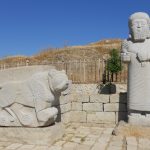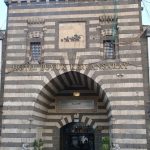Ancient wayside inns
Wherever you go in Turkey you are likely to come across the remains of the old caravanserais and hans that provided resting places for travelling salesmen and their pack animals in the Middle Ages. Traditionally they were able to stay for three nights at each han free of charge.
Most caravanserais consist of large building with a windowless external wall and a striking entrance that opens onto a courtyard ringed with a portico and small rooms in which visitors would stay. Often the rooms are on two storeys. In the middle of the courtyard there is often a raised mescid where they could pray. At the rear of the courtyard opposite the entrance there was usually a large stable for camels, horses and donkeys.
It’s not always easy to decide what should be called a caravanserai and what a han since both served more or less the same function. The most useful rule of thumb is probably that the caravanserais were built in the countryside while the hans were built in the towns.
Some of the most impressive ruins are of buildings erected in the Selçuk era; some of the sturdiest for which new uses have been found date back to early Ottoman times.
These are some of the most interesting caravanserais. Be warned that some may feel that recent “restoration” of the caravanserais has rendered many of them less romantic than they were in their ruinous state (I think particularly of the Alayhan and Tepesidilek caravanserais in Cappadocia).
Ağızkarahan, near Aksaray
El-Aman Hanı, near Bitlis
Han-el Ba’rur, near Harran
Obruk Hanı, near Sultanhanı
Sarıhan, near Avanos
Sultanhan, Sultanhanı, near Aksaray
Sultan Han, near Kayseri
Taşhan, Cay
Zazadın Hanı, near Konya
This is expert Katharine Branning’s list of Selçuk caravanserais/hans: http://www.turkishhan.org/homebase.htm


